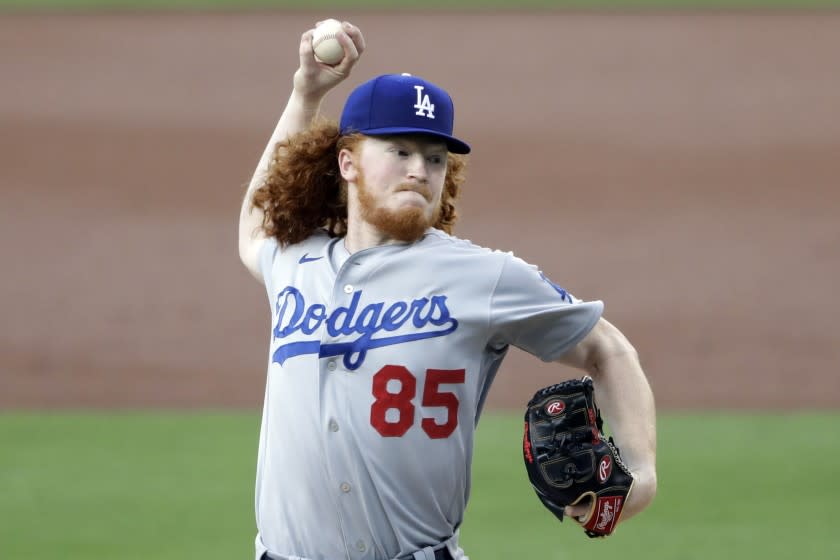Dodgers and Angels remain stark contrasts in young, reliable pitching depth

The Dodgers led the major leagues in earned-run average last season.
They shed three of their starting pitchers in the winter. Of their projected five starters this season, one opted out because of coronavirus concerns, and two others have been injured.
So, of course, the Dodgers lead the majors in ERA this season.
The Dodgers talk about depth a lot, to the point where it can sound like a buzzword, but there is a strategy behind the strategy. Every team subscribes to the theory that you can never have too much pitching. The Dodgers’ addendum: Get deeper by getting younger.
The three starters the Dodgers let go: Rich Hill (40), Hyun-Jin Ryu (33) and Kenta Maeda (32).
The current six-man rotation includes no one older than 32: Clayton Kershaw (32), Ross Stripling (30), Walker Buehler (26), Tony Gonsolin (26), Julio Urías (24) and Dustin May (22). Awaiting activation: Alex Wood (29).
“We took a little bit of a leap in terms of having less established depth, but we felt really good about the talent of the pitchers we had in our organization,” said Andrew Friedman, the Dodgers’ president of baseball operations.
“We showcased it a little earlier than we would have liked, but to their credit, Dustin and Tony have really come on. We’re watching Julio develop into a really good major league starter.”
Of those six, all but Wood originally were signed by the Dodgers. Lined up behind them, and ready to pitch in this season: Mitchell White (25), Victor Gonzalez (24) and Josiah Gray (22). White and Gonzalez originally were signed by the Dodgers; Gray was one of two prospects obtained in a trade with Cincinnati. The other prospect, infielder Jeter Downs, later was included in the package traded for Mookie Betts and David Price.
The trouble with building depth through free agency is that a pitcher talented enough to win a job in one team’s starting rotation probably would not take a minor league offer from another.
“They don’t want to sign up to be starting pitcher No. 6 or No. 7,” Friedman said.
“Really, the only way to maintain high-quality depth is to maintain a player development system that is churning out really good pitching prospects.”
It was no coincidence, then, that a team that moved on from a trio of veteran starters last winter, that could let Wood go this fall and could let Kershaw go next fall, prioritized college pitching in this year’s draft — in Friedman’s words: “three big-talent arms with our first three picks that have a chance to be here sooner rather than later.”
The Dodgers this weekend play the Angels, whose team ERA ranks 22nd among the 30 teams. The Angels’ current rotation includes one homegrown starter, 24-year-old Griffin Canning.
The Dodgers haven’t finished outside the top 10 in ERA since 2010. The Angels haven’t finished inside the top 10 since 2011.
The last Angels pitcher to win 12 games and pitch 150 innings in a season was homegrown: Jered Weaver, drafted in 2004.
Bad boys and bubbles

On Aug. 3, with his team shut down and half the roster infected by the novel coronavirus, Miami Marlins chief executive Derek Jeter shot down reports that players had gone out drinking and clubbing in Atlanta.
“We had guys leave to get coffee, to get clothes,” Jeter said. “A guy left to have dinner at a teammate's house.”
The lesson MLB wanted players to learn: Leaving the hotel for any reason puts you in the community, and thus increases your risk of contracting the virus and then spreading it among your teammates.
The league also ordered teams to add a compliance monitor for road trips. Five days after Jeter spoke up, the Cleveland Indians’ monitor caught pitcher Zach Plesac coming back to the team hotel late at night. The Indians later learned pitcher Mike Clevinger had been out with Plesac.
On an Instagram video posted Thursday, Plesac said the two had joined a small group of friends out at dinner and then back at a private home. He said everyone in the group had been tested and he did not consider his behavior reckless.
“Things are inevitable,” Plesac said. “You’re going to see people. You’re going to socially interact. You can’t sit in a room all day. That’s the truth of the matter.”
The Indians were angered by the video, which has since been deleted. After a team meeting Friday, the Indians optioned both pitchers off the major league roster. It's easy to make a statement with a middle reliever, but Plesac ranked third in the American League with a 1.29 ERA. And, since 2018, Clevinger's 2.92 ERA ranked fourth in the AL, trailing only Justin Verlander, Gerrit Cole and Blake Snell.
Plesac’s comments reflect why MLB is strongly considering a postseason bubble. The league tried to play on the honor system, with players asked not to go anywhere besides home, hotel and ballpark, but all it takes is one or two players out of 900 to trigger an outbreak. It is, to use Plesac’s word, inevitable.
The bubble planning is in its preliminary stages, and the league has not committed to it. But, with October weather as a factor, it is expected that any bubble format would be played partly or entirely in Southern California.
The team that won the World Series has celebrated on the field at Dodger Stadium twice within the last three years, but neither of those teams was the Dodgers. Third time’s the charm?
Fightin' friars
The National League team with the next-best odds? That would be the San Diego Padres, who split a four-game series against the Dodgers this week. Fangraphs gives the Padres an 84% chance to win a playoff berth, which would be their first since 2006.
Bring back the brown and gold uniforms, and glory follows. But shortstop Fernando Tatis Jr., the NL co-leader in home runs, helps too.

